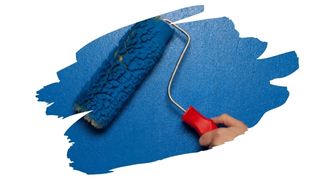If you’re want to cover up the tell-tale signs of wood hardener in your home, then a simple paint job is your best option. That’s because the right choice of color can turn a weary looking bathroom into a rustic style paradise.
However, wood hardeners are nothing like natural wood. And their tough material simply cannot absorb traditional wood finishes and stains.
But can wood hardener take on a coat of paint?
Well, in this post, we look at what really goes into wood hardeners. We also cover why these tough resins are nothing like natural wood (or epoxy wood fillers).
And are you struggling to get wood hardener to sink down into that timber surface? Well, keep reading to find out a quick way to get wood to absorb even the most viscous hardener product.

This post may contain affiliate links to products that we receive a commission for (at no additional cost to you). Learn more here.
What Is Wood Hardener Made From?
Wood hardeners are made from thermoplastic acrylic resins. These resins are key to preventing rotting wooden beams from completely falling apart (if you catch wood rot early enough). That’s because this substance forms an incredibly tough material that is much harder (and water resistant) than even the very wood it’s been applied to.
Is Wood Hardener Simply Another Type Of Epoxy Wood Filler?
While both wood hardeners and epoxy resins cure into hard substances, their base ingredients are very different.
Wood hardeners contain acrylic resins, which is made from acrylic acid and acrylate monomers. While epoxy contains epoxy resins, which are made from polyepoxides.
Related Post: Can You Put Epoxy Over Linseed Oil (For A Longer Lasting Finish)?
Does Wood Hardener Actually Work?
Wood hardener is a quick and easy way to maintain the integrity of rotting wood beams — whether they be in your bathroom or even around your kitchen sink.
Related Post: Rotting Wood Around Your Sink? 3 Ways To Protect That Wooden Worktop
However, wood hardeners work by reinforcing the rot-free sections of a beam. But, wood hardeners do not restore already rotted and decayed sections of wood. You would need to use a wood filler product, (such as Epoxy wood fillers), to pack out otherwise crumbling sections of rotted wood.
That is why a hardener product should be used as soon as possible, to prevent the spread of wood rot.
Can Wood Hardener Be Painted?
A coat of paint will adhere over wood hardener. And, if you use a primer base coat, you’ll have no problem getting paint to stick atop hardener-treated wood.
But, this all comes with two key caveats; 1). You must only paint onto dry wood, and 2). You must repair the sections of already rotted wood before you start painting.
What Happens If You Paint Over Wood Rot?
Well, wood rot is the result of fungi literally eating away at the damp wood fibers. So, if you want to stop the spread of rot, you simply let wood dry out. That’s because wood rot bacteria can only chew their way through moisture-dampened wood.
However, if you paint over still-damp rotting wood, this will do nothing to stop the spread of rot.
So, always wait for wood to dry out, before you start painting.
Also, it’s worth repeating that, wood hardener is simply there to save the rot-free sections of wood. But, you must remove and replace the rot-riddled sections of wood with wood filler.
This is why you must also always repair wood (using wood filler) before you begin painting.
Should I Use Wood Hardener Before I Start Painting?
Yes, you should. Wood hardeners work by soaking down into wood pores and filling them out.
However, if you apply a coat of paint before wood hardener, the paint will seal over those wood pores. And this will make it difficult for wood hardener to sink down into wood.
Another important reason for applying wood hardener first, is that you must stop the further spread of rot. That includes using wood hardener and wood filler. It also means you must fix whatever is causing moisture to get into that timber in the first place.
Related Post: What To Do About Rotting Wood In Your Bathroom
Can You Use Wood Hardener On Wet Wood?
If wood has a high amount of water in it, (also referred to as its moisture content), that’ll prevent hardeners from sinking into lumber. And wood hardeners will only work properly if they are fully absorbed into wood.
So, allow wood sufficient time to dry out before you get to work. This can take around 1-2 weeks (depending on how warm it is in your local climate).
Top Quick Wood Hardener Application Tip: Wood hardeners are very thick. So, try drilling a few small holes across that wooden surface. This will allow hardeners to sink down into wood more easily.
To Wrap Up, Here Are The 3 Key Takeaways From This Post…
- 1). Wood hardeners are made from tough durable thermoplastic acrylic resins. So, this substance can take a top coat of paint.
- 2). For best adhesion, do not apply paint directly onto bare wood/wood hardener. Instead, use a primer undercoat to prepare the surface for a top coat of paint.
- 3). Always allow wood to wholly dry out first before you apply a primer or paint.
References:
Okadaa, Katsuhiko, Kouichi Yamaguchi, and Hirofumi Takeda. “Acrylic/polyester hybrid powder coating system having excellent weather durability.” Progress in organic coatings 34.1-4 (1998): 169-174.
Hsissou, Rachid. “Review on epoxy polymers and its composites as a potential anticorrosive coatings for carbon steel in 3.5% NaCl solution: Computational approaches.” Journal of Molecular Liquids 336 (2021): 116307.



